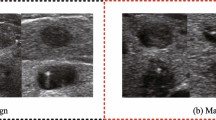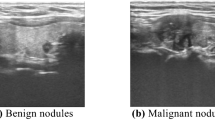Abstract
How to differentiate thyroid cancer nodules from a large number of benign nodules is always a challenging subject for clinicians. This paper proposes a novel Sal-deel network model to achieve the classification and diagnosis of thyroid cancer, which can simulate visual attention mechanism. The Sal-deep network introduces saliency map as an additional information on the deep residual network, which selectively enhances the feature extracted from different regions according to the mask map. Sal-deep network can work effectively for the benchmark networks with different data sets and different structures, and it is a universal network model. Sal-deep network increases the complexity of the network, but improves the efficiency of the network. A large number of qualitative and quantitative experiments show that our improved network is superior to other existing deep models in terms of classification accuracy rate and Recall, which is suitable for clinical application.




Similar content being viewed by others
References
Gopinath, B., and Shanthi, N., Computer-aided diagnosis system for classifying benign and malignant thyroid nodules in multi-stained fnab cytological images. Australasian Physical & Engineering Sciences in Medicine 36(2):219–230, 2013.
Li, H., Weng, J., Shi, Y., Gu, W., Mao, Y., Wang, Y. et al., An improved deep learning approach for detection of thyroid papillary cancer in ultrasound images. Sci. Rep. 8(1):6600–6612, 2018.
Halicek, M., Lu, G. et al., Deep convolutional neural networks for classifying head and neck cancer using hyperspectral imaging. J. Biomed. Opt. 22(6):496–503, 2017.
Lecun, Y., Bengio, Y., and Hinton, G., Deep learning. Nature 51(7):436–461, 2015.
Kereliuk, C., Sturm, B., and Larsen, J., Deep learning and music adversaries. IEEE Transactions on Multimedia 17(11):1–17, 2015.
Kyathanahally, S. P., Dring, A., and Kreis, R., Deep learning approaches for detection and removal of ghosting artifacts in mr spectroscopy. Magn. Reson. Med. 24(6):12–23, 2018.
Hassan, Y. F., Deep learning architecture using rough sets and rough neural networks. Kybernetes. Knowledge-Based Systems 46(4):693–705, 2017.
Randle, R. W. et al., Trends in the presentation, treatment, and survival of patients with medullary thyroid cancer over the past 30 years. Magn. Reson. Med. 16(1):137–146, 2017.
Qian, P., Jiang, Y., Deng, Z., Lingzhi, H., Sun, S., Wang, S., and Jr, R. F. M., Cluster prototypes and fuzzy memberships jointly leveraged cross-domain maximum entropy clustering. IEEE Transactions on Cybernetics 46(1):181–193, 2016.
Qian, P., Jiang, Y., Wang, S., Kuan-Hao, S., Wang, J., Lingzhi, H., and Jr, R. F. M., Affinity and penalty jointly constrained spectral clustering with all-compatibility, flexibility, and robustness. IEEE Transactions on Neural Networks and Learning Systems 28(5):1123–1138, 2017.
Qian, P., Zhao, K., Jiang, Y., Su, K.-H., Deng, Z., Wang, S., and Muzic, Jr., R. F., Knowledge-leveraged transfer fuzzy c-means for texture image segmentation with self-adaptive cluster prototype matching. Knowl.-Based Syst. 130:33–50, 2017.
Jiang, Y., Deng, Z., Chung, F.-L., Wang, G., Qian, P., Choi, K.-S., and Wang, S., Recognition of Epileptic EEG Signals Using a Novel Multi-View TSK Fuzzy System. IEEE Trans. Fuzzy Systems 25(1):3–20, 2017.
Wang, Z., Ren, J., Zhang, D. et al., A Deep-Learning Based Feature Hybrid Framework for Spatiotemporal Saliency Detection inside Videos. Neurocomputing:S0925231218301097, 2018.
Meijun, S., Ziqi, Z., Qinghua, H. et al., SG-FCN: A Motion and Memory-Based Deep Learning Model for Video Saliency Detection. IEEE Transactions on Cybernetics 2018:1–12.
Jiang, Y., Chung, F.-L., Wang, S., Deng, Z., Wang, J., and Qian, P., Collaborative fuzzy clustering from multiple weighted views. IEEE Transactions on Cybernetics 45(4):688–701, 2015.
Jiang, Y., Chung, F.-L., Ishibuchi, H. et al., Multitask TSK fuzzy system modeling by mining intertask common hidden structure. IEEE Transactions on Cybernetics 45(3):548–561, 2015.
Xia, K.-J., Yin, H.-S., and Zhang, Y.-d., Deep Semantic Segmentation of Kidney and Space-Occupying Lesion Area Based on SCNN and ResNet Models Combined with SIFT-Flow Algorithm. J. Med. Syst. 43(23):122:143, 2019.
Xia, K. J., Yin, H. S., and Wang, J. Q., A novel improved deep convolutional neural network model for medical image fusion. Clust. Comput. 2018(3):1–13.
Sun, M., Zhou, Z., Zhang, D. et al., Hybrid convolutional neural networks and optical flow for video visual attention prediction. Multimed. Tools Appl. 24(23):56–65, 2018.
Hou, W., and Gao, X., Saliency-guided deep framework for image quality assessment. IEEE MultiMedia 22(2):1–17, 2015.
Xia, K., Wang, J., and Wu, Y., Robust Alzheimer Disease classification based on Feature Integration Fusion Model for Magnetic. Journal of Journal of medical imaging and health informatics 7:1–6, 2017.
Xia, K., Yin, H., Qian, P., Jiang, Y., and Wang, S., Liver Semantic Segmentation Algorithm Based on Improved Deep Adversarial Networks in Combination of Weighted Loss Function on Abdominal CT Images. IEEE Access 7:96349–96358, 2019.
Obeso, A. M., Vázquez, M. S. G., Acosta, A. Á. R. et al., Connoisseur: classification of styles of Mexican architectural heritage with deep learning and visual attention prediction. International Workshop.:780–783, 2018.
Wang G, Wang W, Wang J, et al. Better deep visual attention with reinforcement learning in action recognition. 2017 IEEE International Symposium on Circuits and Systems (ISCAS). IEEE, 2017:19-23.
Huang W, He D, Yang X, et al. Detecting Arbitrary Oriented Text in the Wild with a Visual Attention Model. Acm on Multimedia Conference. ACM, 2016:1208-1212.
Zhao, B., Feng, J., Wu, X. et al., A survey on deep learning-based fine-grained object classification and semantic segmentation. Int. J. Autom. Comput. 14(2):119–135, 2017.
Di Cataldo, S., and Ficarra, E., Mining textural knowledge in biological images: Applications, methods and trends. Computational and Structural Biotechnology Journal 15:56–67, 2017.
Im, D. J., Kim, C. D., Jiang, H. et al., Generating images with recurrent adversarial networks. Neurocomputing 23(11):21–33, 2016.
Shameer, K., Badgeley, M. A., Miotto, R. et al., Translational bioinformatics in the era of real-time biomedical, health care and wellness data streams. Brief. Bioinform. 18(1):105–124, 2017.
Fei-Yan, Z., Lin-Peng, J., and Jun, D., Review of Convolutional Neural Network. Chinese Journal of Computers 22(22):123–138, 2017.
Acknowledgments
This work is financially supported by Zhejiang Provincial Fund Joint Fund of Mathematical and Physical Medical Association (LSY19H180010).
Author information
Authors and Affiliations
Corresponding author
Ethics declarations
Conflict of interest
We declare that we have no conflict of interest.
Human and animal rights
The paper does not contain any studies with human participants or animals performed by any of the authors.
Informed consent
Informed consent is obtained from all individual participants included in the study.
Additional information
Publisher’s Note
Springer Nature remains neutral with regard to jurisdictional claims in published maps and institutional affiliations.
This article is part of the Topical Collection on Image & Signal Processing
Rights and permissions
About this article
Cite this article
Zhang, Y. Classification and Diagnosis of Thyroid Carcinoma Using Reinforcement Residual Network with Visual Attention Mechanisms in Ultrasound Images. J Med Syst 43, 323 (2019). https://doi.org/10.1007/s10916-019-1448-5
Received:
Accepted:
Published:
DOI: https://doi.org/10.1007/s10916-019-1448-5




